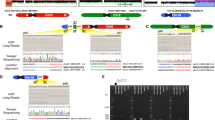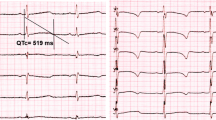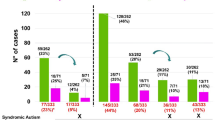Abstract
Crigler–Najjar syndrome type I (CN-I) is a rare and severe autosomal recessive metabolic disease due to a total deficiency of bilirubin uridine diphosphate glucuronosyltransferase located on chromosome 2. We report on a child with CN-I due to a phenylalanine residue deletion inherited only from the father carrying this deletion at the heterozygous state. Cytogenetic analyses showed no deletion of the chromosomal 2q37 region. Microsatellite analysis of the child and his parents was consistent with paternal isodisomy for chromosome 2 in the child. This report demonstrates that uniparental disomy may be at the origin of very rare diseases transmitted as autosomal recessive traits and emphasizes the need for parental DNA analysis in such cases.
Similar content being viewed by others
Log in or create a free account to read this content
Gain free access to this article, as well as selected content from this journal and more on nature.com
or
References
Engel E : A new genetic concept: uniparental disomy and its potential effect, isodisomy. Am J Med Genet 1980; 6: 137–143.
Engel E, DeLozier-Blanchet CD : Uniparental disomy, isodisomy, and imprinting: probable effects in man and strategies for their detection. Am J Med Genet 1991; 40: 432–439.
Kotzot D : Abnormal phenotypes in uniparental disomy (UPD): fundamental aspects and a critical review with bibliography of UPD other than 15. Am J Med Genet 1999; 82: 265–274.
Hansen WF, Bernard LE, Langlois S et al: Maternal uniparental disomy of chromosome 2 and confined placental mosaicism for trisomy 2 in a fetus with intrauterine growth restriction, hypospadias, and oligohydramnios. Prenat Diagn 1997; 17: 443–450.
Wolstenholme J, White I, Sturgiss S, Carter J, Plant N, Goodship JA : Maternal uniparental heterodisomy for chromosome 2: detection through ‘atypical’ maternal AFP/hCG levels, with an update on previous case. Prenat Diagn 2001; 21: 813–817.
Harrison K, Eisenger K, Anyane-Yeboa K, Brown S : Maternal uniparental disomy of chromosome 2 in a baby with trisomy 2 mosaicism in amniotic fluid culture. Am J Med Genet 1995; 58: 147–151.
Webb AL, Sturgiss S, Warwicker P, Robson SC, Goodship JA, Wolstenholme J : Maternal uniparental disomy for chromosome 2 in association with confined placental mosaicism for trisomy 2 and severe intrauterine growth retardation. Prenat Diagn 1996; 16: 958–962.
Spiekerkoetter U, Eeds A, Yue Z, Haines J, Strauss AW, Summar M : Uniparental disomy of chromosome 2 resulting in lethal trifunctional protein deficiency due to homozygous alpha-subunit mutations. Hum Mut 2002; 20: 447–451.
Thompson DA, McHenry CL, Li Y et al: Retinal dystrophy due to paternal isodisomy for chromosome 1 or chromosome 2, with homoallelism for mutations in RPE65 or MERTK, respectively. Am J Hum Genet 2002; 70: 224–229.
Chavez B, Valdez E, Vilchis F : Uniparental disomy in steroid 5alpha-reductase 2 deficiency. J Clin Endocrinol Metab 2000; 85: 3147–3150.
Arias IM, Gartner LM, Cohen M, Ezzer JB, Levi AJ : Chronic nonhemolytic unconjugated hyperbilirubinemia with glucuronyl transferase deficiency. Clinical, biochemical, pharmacologic and genetic evidence for heterogeneity. Am J Med 1969; 47: 395–409.
Bosma PJ, Chowdhury NR, Goldhoorn BG et al: Sequence of exons and the flanking regions of human bilirubin-UDP-glucuronosyltransferase gene complex and identification of a genetic mutation in a patient with Crigler–Najjar syndrome, type I. Hepatology 1992; 15: 941–947.
Kadakol A, Ghosh SS, Sappal BS, Sharma G, Chowdhury JR, Chowdhury NR : Genetic lesions of bilirubin uridine-diphosphoglucuronate glucuronosyltransferase (UGT1A1) causing Crigler–Najjar and Gilbert syndromes: correlation of genotype to phenotype. Hum Mutat 2000; 16: 297–306.
Ritter JK, Yeatman MT, Ferreira P, Owens IS : Identification of a genetic alteration in the code for bilirubin UDP-glucuronosyltransferase in the UGT1 gene complex of a Crigler–Najjar type I patient. J Clin Invest 1992; 90: 150–155.
Labrune P, Myara A, Hadchouel M et al: Genetic heterogeneity of Crigler–Najjar syndrome type I: a study of 14 cases. Hum Genet 1994; 94: 693–697.
Rosatelli MC, Meloni A, Faa V et al: Molecular analysis of patients of Sardinian descent with Crigler–Najjar syndrome type I. J Med Genet 1997; 34: 122–125.
Francoual J, Rivierre A, Mokrani C et al: Crigler–Najjar syndrome type I in Tunisia may be associated with founder effect related to the Q357R mutation within the UGT1 gene. Hum Mutat 2002; 19: 570–571.
Le Bihan-Lefauvre B, Francoual J, Labrune P, Chalas J, Capel L, Lindenbaum A : Mise au point et intérêt du diagnostic de la maladie de Gilbert par biologie moléculaire. Ann Biol Clin 2001; 59: 61–66.
Aboura A, Coulomb-L'Hermine A, Audibert F, Capron F, Frydman R, Tachdjian G : De novo interstitial direct duplication 1(q23.1q31.1) in a fetus with Pierre Robin sequence and camptodactyly. Am J Med Genet 2002; 108: 153–159.
Ritter JK, Yeatman MT, Kaiser C, Gridelli B, Owens IS : A phenylalanine codon deletion at the UGT1 gene complex locus of a Crigler–Najjar type I patient generates a pH-sensitive bilirubin UDP-glucuronosyltransferase. J Biol Chem 1993; 268: 23573–23579.
Rosatelli MC, Meloni A, Faà V et al: Molecular analysis of patients of sardanian descent with Crigler–Najjar syndrome type I. J Med Genet 1997; 34: 122–125.
Ciotti M, Cho JW, George J, Owens IS : Required buried alpha-helical structure in the bilirubin UDP-glucuronosyltransferase, UGT1A1, contains a nonreplaceable phenylalanine. Biochemistry 1998; 37: 11018–11025.
Wolstenholme J : Confined placental mosaicism for trisomies 2, 3, 7, 8, 9, 16, and 22: their incidence, likely origins, and mechanisms for cell lineage compartmentalization. Prenat Diagn 1996; 16: 511–524.
Gibbons B, Cheng HH, Yoong AK, Brown S : Confined placental mosaicism for trisomy 2 with intrauterine growth retardation and severe oligohydramnios in the absence of uniparental disomy in the fetus. Prenat Diagn 1997; 17: 689–690.
Kadakol A, Sappal BS, Ghosh SS et al: Interaction of coding region mutations and the Gilbert-type promoter abnormality of the UGT1A1 gene causes moderate degrees of unconjugated hyperbilirubinaemia and may lead to neonatal kernicterus. J Med Genet 2001; 38: 244–249.
Francoual J, Trioche P, Mokrani C et al: Prenatal diagnosis of Crigler–Najjar syndrome type I by single-strand conformation polymorphism (SSCP). Prenat Diagn 2002; 22: 914–916.
Ciotti M, Chen F, Rubaltelli FF, Owens IS : Coding defect and a TATA box mutation at the bilirubin UDP-glucuronosyltransferase gene cause Crigler–Najjar type I disease. Biochim Biophys Acta 1998; 1407: 40–50.
Acknowledgements
We thank Dr Sophie Brisset for cytogenetical analysis.
Author information
Authors and Affiliations
Corresponding author
Rights and permissions
About this article
Cite this article
Petit, F., Gajdos, V., Parisot, F. et al. Paternal isodisomy for chromosome 2 as the cause of Crigler–Najjar type I syndrome. Eur J Hum Genet 13, 278–282 (2005). https://doi.org/10.1038/sj.ejhg.5201342
Received:
Revised:
Accepted:
Published:
Issue date:
DOI: https://doi.org/10.1038/sj.ejhg.5201342
Keywords
This article is cited by
-
A compendium and functional characterization of mammalian genes involved in adaptation to Arctic or Antarctic environments
BMC Genetics (2017)
-
Maternal uniparental heterodisomy with partial isodisomy of a chromosome 2 carrying a splice acceptor site mutation (IVS9–2A>T) in ALS2 causes infantile-onset ascending spastic paralysis (IAHSP)
neurogenetics (2009)
-
Deletions of 2q14 that include the homeobox engrailed 1 (EN1) transcription factor are compatible with a normal phenotype
European Journal of Human Genetics (2006)
-
A fascination with chromosome rescue in uniparental disomy: Mendelian recessive outlaws and imprinting copyrights infringements
European Journal of Human Genetics (2006)



